Upgrading RAM on MacBook
I knew when I purchased my MacBook that the 512MB of RAM which it came with wouldn’t suffice for my needs. I held off until I could justify upgrading the RAM as I have the luxury of owning two Macs. I use my iMac for anything intensive and my MacBook as a second machine. As my iMac is home alone in Cork and I’m up in the “Big Smoke” of exotic Dublin, the time had finally come to upgrade.
And thus began a little bit of research into the matter of upgrading RAM on a MacBook..
The first thing you need to do is to find out what type of RAM comes installed on your MacBook. You can check this by clicking on the Apple Icon and by going to ‘About This Mac’. The second row will indicate the type of RAM you have. In my case I have 2GB 667 HMz DDR2 SDRAM (previously I had 512MB).
Once you know what you need to buy you need to find a reseller. Steer well clear of Apple when buying RAM. A quick search for RAM at Applestore.ie indicates that 2GB of RAM would cost me €290!
Crucial are by far the cheapest supplier of RAM. I purchased the same 2GB of RAM which Apple had priced at €290 for €70. That’s more than a 400% difference in price.
The Crucial website is extermely user friendly when selecting your product. They have a step by step ’shop assistant’ which guides you to the correct product before checking out. Be sure to avoid any confusion by double checking your processor type when selecting your model as there are Intel Core Duo and Intel Core 2 Duo types available.
RAM has never been cheaper so go for as much RAM as you can afford.
I ordered my 2GBs of RAM on a Tuesday evening from Crucial’s American based store and I had the package in my hands on a Friday morning in Dublin! I was extremely impressed with their speedy delivery!
The actual RAM installation was an absolute breeze. The only thing you should be made aware of are Apple’s use of tiny screws. You will need a screwdriver such as a Phillips size 00 screwdriver to complete the job.
There is an excellent guide on how to install RAM on a MacBook on apples’ site.
When placing the RAM within the slot be sure to apply firm pressure in order to get it into the bracket provided. If you place your fingers at either end of the inserted RAM and if you notice that you can slightly nudge the RAM then you haven’t applied enough pressure.
I have a single GB of RAM on my iMac and no doubt I’ll be upgrading that in the not too distant future as well.
Release "Recent Application" feature on Mac
This tweak is very useful, i cant imagine why apple hasn't integrated it itself (there aren't lots of things apple hasn't thought about in its OS unlike windows where third party is necessary and no way to do without)

this tweak adds a recently used application stack to the dock and allows to see as a stack the recent applications you lunched.
in order to do that open terminal and use this command (don't use sudo!):
defaults write com.apple.dock persistent-others -array-add '{ "tile-data" = { "list-type" = 1; }; "tile-type" = "recents-tile"; }'
killall Dock
after the stack is in the dock you can change it to show one of:
"Recent Applications"
"Recent Documents"
"Recent Server" (no icons for some reason)
"Favorite volumes"
"Favorite Items"
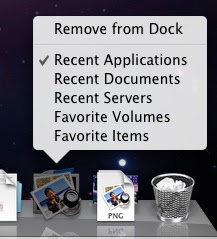
also you can call the command several times and add as many stacks as you want so you can have "Recent Documents" and "Recent Applications" as etc.


a
Show "Date and Time" in menu bar
The menu bar clock always annoyed me since even windows clock supplied more data, and the maximum i got from the menu bar clock beside the time was day.
well i found out that there is a way to make the date year and the whole shebang appear, this is how to do it:
1. right click the menu bar clock and choose "Open Date & Time ..."


2. click on the "Open International ..." button

3. select "Formats" tab

4. in the Dates section press "Customize ..." button, in the Show drop down select Medium

5. set your preferred format by dragging the appropriate "Time Elements" and clicking on them to set more details


6. then select all time elements at the text field by Option+A and copy by Option+C (or drag to select and right click empty space and copy)

7. press "OK" and then "Customize ..." at the Times section
8. from the "Show" drop down select "Full" (remove unwanted elements such as seconds or GMT...)

9. left to the time elements paste by Option+V (or right click paste)

10. press space to separate time and date and click OK

thats it you now have date in the menu bar clock.
Quick Silver
I am not sure how i stumblled upon Quick Silver, but it should be the first App to be installed on every new mac.
Quick Silver is a utility that extend the Finder capabilities, it is a combination of a search engine (like SpotLight and GoogleDesktop) with right click abilities, and then some (Open, Delete, Rename, Mail to...).
the idea is simple (like all great things are), to allow a user from the keyboard to perform (almost) all actions on a resource (Application, File, Folder, Network share, URL, etc...)
there are many advanced abilities, several User Interface, and endless list of plugins,
Quick Silver is available for mac only, (windows users have replica like Launchy, and SkyLine) QS is available for download from these locations:
BlackTree - Home Site
SoftPedia - Mirror 1
MacUpdate - Mirror 2 (love macupdate)
VersionTracker - Mirror 3 (track versions. what a great idea)
hope you will love QS as much as i do.
Adding "New File" in Context Menu
Another feature that is absent (i don't really need it) from mac but exist in windows is the right-click "New file_type..." for instnce "New Text File",
well come to think of it thats about it! i never used the other file types, pictures? there are too many types to put there and i always used photoshop/msPaint etc in order to create one and even if i did create one i then go right away and open the application that edit them so what is the use? the same goes to word, power point and excel what ever.
so for the sake of argument lets assume we want the new txt file ability, so there is another add on utility that adds it self to the context menu More sub menu and allow create new document types from templates and it allows you to add templates and types of your own, and edit the one that exists, its really good and quite simple (as most good things are) it only copy the template to the place you clicked.
it is called "Nufile" it can be downloaded from here.
the installation is simple (next next next, or as mac version: continue, continue, continue)
and the result looks like this:

Add "Cut" Feature
the most absent feature in mac is the right click->cut (on files and folders),
i wonder who is the jerk in apple that is keeping us from getting this feature,
PathFinder is a good replacement for Finder and it has cut feature,
but it lacks several features that the new Finder in leopard has, for instance Cover-Flow, quick look etc.
1. open terminal and write this line:
defaults write com.apple.finder AllowCutForItems 1
2. restart Finder, in terminal write:
killall Finder
or
right click dock finder icon with option button pressed (Alt/WinKey in hackintosh) and choose "relaunch"
to undo this simply execute the same lines only this time replace the value 1 with 0 like this:
defaults write com.apple.finder AllowCutForItems 0
killall Finder

but when you try it you find its just another "move to trash" menu item, well that didn't help,
that was when i decided to download the add on to context menu FileCutter
it
gives you the option to cut paste, move to... etc. but the annoying
part is that it is a sub menu inside a sub menu, in leopard all add ons
to context menu is added to the More sub Menu, and file cutter is a sub
menu in its own, so in order to cut you go 3 levels deep - yuc! i wish
there was a way to add cut directly to the context menu next to copy
feature without any mess

List of Download Mac File, Direct-Link Blog
This are the blog/sites that containt much of Mac files, that you can download freely.
MacFiles - this site has Software,Ebooks,Tutorials,Fonts,Games,Plugins
FullDls - full downloads torrents links, this link is directly to mac sorted by seeders
Fink Project - The Fink project bring the full world of Unix Open Source software to Darwin and Mac OS X.
Mecho DDL - Direct downloads apps games (mac and windows)
Lemon Share - great site with tons of mac apps/games/utils all free all cracked
Mecho Forum - has lots of mag apps/games direct links
No Mercy Mac - another great rapidshare for mac utilities, books, and software
Demonoid Torrents - free torrents site has mac section
Hacker-VIP - hacked premium Mac applications
Rapid Mac - another blogspot that share mac rapidshare links (games, apps, ebooks...)
Mac4Share - Links to popular macintosh software. Software for mac on rapidshare
Phaze DDL - best direct link site on the web got mac section too
Mac 10.5 System Source Code now Available
Apple has published on her site the open source code part of its OS (code name Darwin).
The code can be found here, and it includes bootloader code, frameworks, bundles, and many kext.
Mac shortcut on keyboard button
Every now and then i read of a keyboard trick or shortcut that i didn't know exist,
i have decided to open this post/thread to contain all my findings in this area,
it will be periodically updated instead of opening small posts regarding such shortcuts.
Show in Finder
Command+Click on an icon,shortcut or dock icon and it will open the Finder and locate the original location for that icon.
Make Alias
select an icon (folder, application, document whatever), and just click:
Command+L
iPhoto/iTunes choose library
Option+Click on the icon and it will display a "Choose Library..." dialog, in case you would like to split your libraries and save disk/partition space.


Switch between tabs in safari
Command+Shift+LeftArrow or Command+Shift+RightArrow
Open new tab in safari
Command+T
Open new window in safari
Command+N
Go To in Finder
Command+Shift+G
it will open a text-field dialog allowing any path to be clicked, and you can use tab to autocomplete just like in terminal, and if you won't press tab and just wait for a second or two it will suggest the correct word as you type.

SpotLight search from keyboard
Ctrl+Space
"Show icons as" in Finder from keyboard
Command+1 up to Command+4
Delete without drag to trash
select the files/folders you want to delete and press:
Command+Backspace
"Empty trash" from keyboard (when Finder in focus)
Command+Shift+Backspace
Open Special folders
when finder is the focused application:
Command+Shift+H Home
Command+Shift+D Desktop
Command+Shift+K Network
Command+Shift+U Utilities
Command+Shift+C Computer
Open FrontRow
Command+Esc
Help Menu
Command+Shift+? Help
Block select in Terminal
Option+Click+Drag it will select block in the terminal

Back and Forward
Command+[ Back
Command+] Forward
it will work in Safari and Finder (not sure where else)
Menu with keyboard
Ctrl+F2
Dock with keyboard
Ctrl+F3
Rearange MenuBar
Command+Click+Drag
you can rearrange and also remove by dragging out of the menubar
Eject all removable media
in order to eject all removable media (CD, DVD, etc.) Simply:
Press and Hold F12
Hide current window and focus the next
if you hold down Option and click on a window the current window will hide,
if you reach to a point where all windows are hidden (or one is still visible),
then you can move between windows (even by clicking on the dock icon) and only one window will be visible at any given moment.
Option+Click on next window
Ctrl+Alt+Del on Mac
the combination is Command+Option+Esc
in hackintosh its: WinKey+Alt+Esc
it will display the open applications and you can choose to quite or force quit
Minimize Window
Command+M
Hidden menu commands
some menu will change their strings and keyboard shortcuts,
or even display hidden menu item if you hold down the Command or Option key while the menu display.
for instance right click Finder Dock icon and press Option (if already displayed will show "Hide Others" instead of "Hide") if pressed during right click will show hidden "Relaunch" menu item.
another example is to press the apple menu and hold down the Option key, it will change "About this mac" to "System Profiler" the shutdown,restart and logout to immediately do the action without a dialog and time wait period.
another example: in Finder hold down Option key and the Quick look icon will turn to slideShow icon.
QuickLook Full Screen
Command+Option+Y
Auto Hide the Dock
Command+Option+D
Search in dictionary (for Cocoa Application)
Zoom In: Command+Option++
Zoom Out: Command+Option+-
the complete list of OS X keyboard shortcuts found here.
How-To Install and Boot from new kernel
This post will display how to install new kernel, and it will also display how to boot from alternative kernel, plus some trouble shooting advices.
1. what is a kernel?
Kernel is the core and center of the OS, it interface the hardware and it is the nearest code to hardware there is, it gives the OS and the applications services on the computer (such as CPU, memory access, threading, networking, filesystem etc.) for further reading you can refer to my dev blog post: Kernel Basics.
the reasons mostly comes from bug fixed, features added to hackintosh and not available with the version you are using, or just to know you are up-to-date (any new post in insanelymac, netkas or on the net will relate to your version), if you are not confidant in your abilities to update the kernel, then avoid it until you must, it can crash your system (although can be easily reversed)
- EFI supported kernel are available at netkas blog links from the irc channel.
- you can also download the latest kernel and its relevant kext from the open source darwin project, compile it, and patch it using netkas EFI patch using this procedure(for more advanced users - not recommended).
once downloaded (probably from netks blog) backup your current kernel (/mach_kernel), copy it to the root file system and rename it to "mach_kernel", fix permissions, and your done.
now for the step by step procedure:
a. download the binary mach_kernel file into a folder (for instance desktop)
b. copy the file from downloaded folder (e.g. desktop) to the root folder
- open terminal
- write: sudo -s
- enter your password when prompt and press enter
- cp ~/Desktop/mach_kernel_9.2 /
c. backup your current kernel by renaming it
- mv /mach_kernel /mach_kernel_9.0
d. rename the downloaded kernel to the mach_kernel file name
- mv /mach_kernel_9.2 /mach_kernel
e. fix permissions and reboot
- chown 0:0 /mach_kernel
- chmod 755 /mach_kernel
5. how to boot from alternate kernel?
if you do not trust the downloaded kernel, you can ask darwin boot loader to load from a different kernel file, just by stating the full path of the kernel as the first parameter in the boot prompt.
for instance if the downloaded kernel name is: mach_kernel_9.2 then you copy it to the root of the files system using finder or terminal, (from command line: cp mach_kernel_9.2 /).
next, in the boot prompt you write: /mach_kernel_9.2 -v
i added the -v so you can see where other parameters goes.
6. what if something goes wrong?
you can easily reverse the procedure, first you can use the boot from alternate kernel, and booting into the backed up kernel (/mach_kernel_9.0 as first parameter to darwin boot loader).
second you can boot from the install DVD into single user mode, mount the file system and rename the new kernel, copy the backed up kernel as /mach_kernel file name and reboot (i will add a post regarding single user boot, mount, and other unix shell commands needed for the procedure).
Tweaking Mac Theme
Is there a possibility to tweak Mac theme? (why would you like to?)
well, according to many articles there is no way to do it since OS X has released.
up to Mac OS 9 mac OS was a UI tweakers paradise, but since OS X was released all tweaking abilities, API, and related utilities was discarded, not supported, hidden using private access etc. (example for such article), later when Leopard arrived even OS X applications that some how managed to work (mostly by accessing unsupported and private APIs) stopped working.
OS X Tiger 10.4.x had several applications like: WindowShade X, ShapeShifter, FruitMenu, ofcource no application is worth without a good theme/visual style/icons... collections.
here are some sites to support these applications:
Max Themes
Interface Lift
Win Customize (although mostly for windows still icon is icon, wallpaper is wallpaper)
what about Leopard?
since Leopard is built out of applications such as "Dock.app", "Finder.app"..., and the applications are folders and can be browsed using "Show Package Contents", you will find in almost any application (or kext or bundle or action or ...) a folder named "Resources", it will contain images, plist XML files, Strings, etc., color, font, size definitions, sounds, icons etc. will reside here as a resource.
if you change many of these OS characteristics you end up with a different look and feel or theme of leopard.
for instance you can check the content of resources folder found at Finder like this:
- goto folder "/System/Library/CoreServices"
- right click file: "Finder.app"
- select "Show Package Contents"
- from the new finder window go in to folder "Contents"
- enter folder "Resources"
you can find and replace the file "burnableFolder.icns" with other icon
from that point on your icon will display differently.

but since we don't like to work manually, we need some theme tweaking apps/utils, luckily that is exactly what i am going to cover.
CandyBar
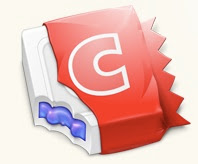
first application is CandyBar the most popular application that knows how to change icons, dock icons, system icons, browse icontainer, etc.
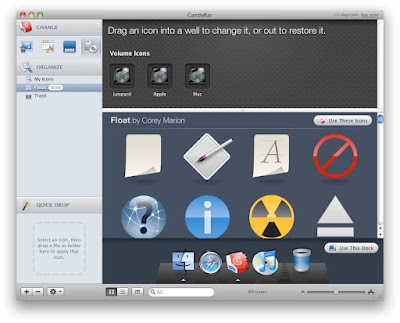
you open up a window that display icons that your current system has and icons that you can replace to. you can add icons of your own, downloaded, you can at any time restore the default icon of each changed icon, it knows to relaunch the dock/finder application when needed (if you allow it), there is a trial version, and it is really easy to use.
you can change the look of your dock for instance as displayed in this post.
here is my resulting Dock:

here are several example of my tweaked icons using CandyBar:
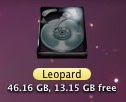


DockColor

next is DockColor, a very very straight forward application, it doesn't get simpler then this.
it is a color picker with a image displaying the Dock surface, you choose the Dock color you want and press apply, thats it (beside of allowing by entering your password).
take a look at the result:

Palette

another good application to change the dock colors is "Palette" it has the ability to control the dock colors with more details such as color opacity, surface image opacity, if the dock frontline is colored with the same color etc.

Palette can also change gradually the translucency of the menu bar (10.5 and 10.5.1 only), use round corners for the menu bar, and change stack icons. the only annoying thing is that the trial version leave text on the dock (i would prefer time period limit) so it is unusable for this purposes.

here are several dock examples:



LeopardDocks

"LeopardDocks" started as a site that display how to tweak the dock and then uploaded many examples and designs, then they came out with LeopardDocks application (was written by "William Spong") that allows you to change the dock look and feel, by downloading a zip file from the "LeopardDocks site" and plug them into the application and change your dock.

one more thing you can do with LeopardDocks is to add a separator between running applications and permanent dock icons, well actually it is an icon that is invisible so you can move it around and even drag it out side of the dock in order to remove it from the dock.

Stacks Drawers
if we are talking about the dock then you need to take a look at the "Add Drawer to Stacks" post that display how to add drawers to the stacks. also i stumbled on this post that is very detailed on the graphical side of creating the drawers.
Displaperture

this application is very weird, its probably for Mac veterans, way back when apple display screen had round corners, not sure if on purpose or outcome of old technology, well if you are one of the old mac users and miss your screen round corners, or just think it's funky then download it from here, run it, choose the corners you would like to be round, scroll the slider to the amount of roundness it needs to be, and press quit. next time you run the application the round corners appears and the application window will not. if you want to setup or quit, just double click the application icon again and the window appears.

what about some content?
well there are a lot of sites that supply icons, wallpapers, stacks icon and application pimping sets. here are some examples:
WebShots
Inner Mind Media
Apple Icons+ScreenSavers
McDo Design
Louie Mantia
GUI Styles
Free Wallpapers
Icons.cx
Dockulicious
Pixel Girl Icons
set of icons
UsingMac
we can also add some command line defaults tweaks:
remove Finder Buttons background
write in terminal:
defaults write "Apple Global Domain" CUIAllowDebugPrefs 1
defaults write "Apple Global Domain" CUIDisableArtFile 1
killall Finder
instead of this:

you should see this:

if you decide to do that you can manually change colors of Cocoa applications in mac (like Finder, Safari, etc.)
you need to go to the folder:
/System/Library/PrivateFrameworks/CoreUI.framework/Versions/A/Resources/AquaUI.bundle/Contents/Resources
and you can edit and change colors of PNG files especially with the word Material in the files name, the previous written terminal commands cause the mac to work using the vector graphics engine that draws its resources from this folder, the material files help mac to decide how a certain color looks if light is dropped in front of an object and what gradient color to use in each corner and angle, also other files used for layers and transparency (alpha) etc.
look at this example called Milk-Like look and feel created by another user on this post:
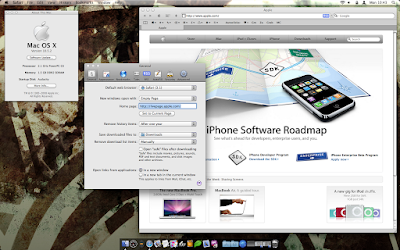
also look at this example a more darker look and feel (notice the close resize minimize buttons):

Note: this will hit your performance badly.
Change Finder Background
- open Finder Window
- right click an empty area
- choose "Show View Options"
- from the lower part (Background) choose Color (or image)
- click on the white color box and choose color
- press "Use as Defaults"
- close the popup
Note: this will work only in Icon View!



Change Selection Color
- from the apple menu goto "System Preferences"
- enter "Appearance" tab
- change "Highlight Color" to whatever you want


Example of two results i got:


 Read More......
Read More......

